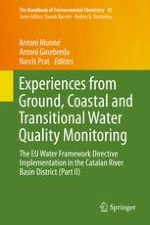2016 | Buch
Experiences from Ground, Coastal and Transitional Water Quality Monitoring
The EU Water Framework Directive Implementation in the Catalan River Basin District (Part II)
herausgegeben von: Antoni Munné, Antoni Ginebreda, Narcís Prat
Verlag: Springer International Publishing
Buchreihe : The Handbook of Environmental Chemistry
